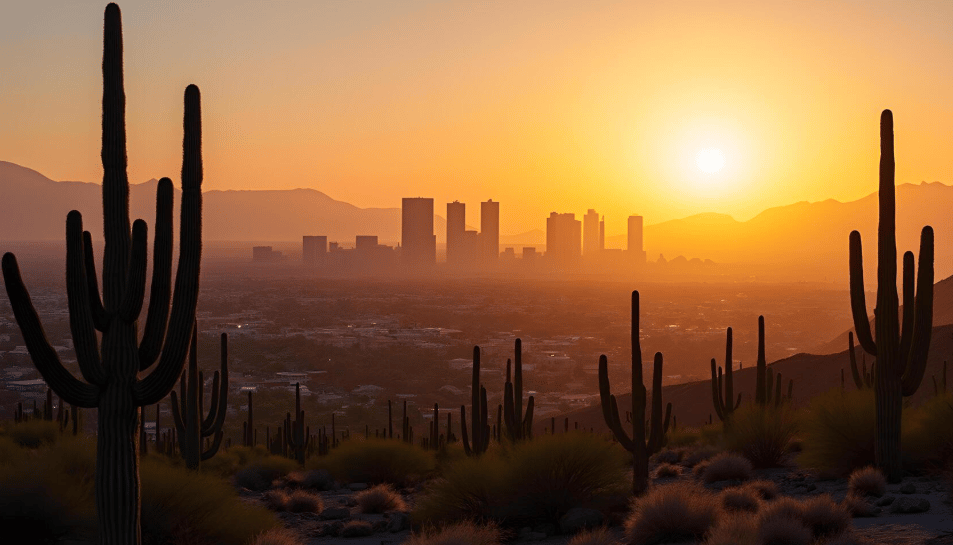There’s a certain magnetism to the desert landscape that continues to draw discerning buyers to Arizona. And within the greater Phoenix Metropolitan Area, the East Valley has emerged as one of its most coveted enclaves. Stretching across communities like Chandler, Gilbert, Mesa, and Queen Creek, the East Valley exudes a balance of residential polish and access to the outdoors, all while offering a contrast to the urban sprawl of the Phoenix Metro core. For those navigating the luxury market, understanding the cost of living in East Valley compared to other parts of the Phoenix Metro offers essential insight for where lifestyle meets value.
Regional Identity: East Valley vs. Phoenix Metro
Both regions share the iconic Sonoran Desert backdrop and fall under the umbrella of the Phoenix Metropolitan Area, but they differ in pace, priorities, and real estate structure. Phoenix Metro includes central areas like Downtown Phoenix, Midtown, Uptown, and Arcadia, along with inner-ring suburbs. The East Valley, on the other hand, extends further east and includes a cluster of suburban cities that feel more residential and master-planned.
These geographic nuances influence everything from property types to day-to-day expenses. The East Valley offers a community-centric lifestyle, often with newer developments and thoughtfully designed neighborhoods. Meanwhile, central Phoenix is evolving as a hub for art, culture, and commerce with denser urban pockets and historic architecture. These lifestyle distinctions are reflected in the cost breakdown.
These geographic nuances influence everything from property types to day-to-day expenses. The East Valley offers a community-centric lifestyle, often with newer developments and thoughtfully designed neighborhoods. Meanwhile, central Phoenix is evolving as a hub for art, culture, and commerce with denser urban pockets and historic architecture. These lifestyle distinctions are reflected in the cost breakdown.
Housing and Real Estate: Where Your Dollar Goes Further
When it comes to high-end real estate, location defines both value and return. The East Valley’s appeal stems in part from its inventory of luxury homes that are often more spacious and newly built compared to similarly priced properties in central Phoenix. Communities like Gilbert and Queen Creek boast custom estates on larger lots, frequently offering mountain views, resort-style pools, and integrated smart home features.
In comparison, central Phoenix and areas like Arcadia or Biltmore are known for their historical charm, premium walkability, and proximity to high-end dining and entertainment. However, given the demand for homes in established neighborhoods, buyers may encounter higher price tags for smaller square footage.
It’s not simply about size, though. Buyers prioritizing turnkey properties with clean architectural lines and space to host will often find more flexible options in the East Valley. While Phoenix offers prestige in its central zones, the East Valley provides a more seamless entry into elevated desert living with room to breathe.
In comparison, central Phoenix and areas like Arcadia or Biltmore are known for their historical charm, premium walkability, and proximity to high-end dining and entertainment. However, given the demand for homes in established neighborhoods, buyers may encounter higher price tags for smaller square footage.
It’s not simply about size, though. Buyers prioritizing turnkey properties with clean architectural lines and space to host will often find more flexible options in the East Valley. While Phoenix offers prestige in its central zones, the East Valley provides a more seamless entry into elevated desert living with room to breathe.
Property Taxes and Utilities: Subtle Differences with a Big Impact
Arizona enjoys relatively moderate property tax rates, but the differences between East Valley cities and Phoenix can influence annual carrying costs. Municipal tax rates in the East Valley tend to hover slightly below those in Phoenix, depending on the city and school district levies involved. For homes in the five to ten million range, even small percentage differences translate to meaningful cost variance over time.
Utility costs are also worth considering. With many East Valley homes being newer builds, energy efficiency is often a built-in feature. High-performance windows, solar arrays, and water-efficient landscaping are increasingly standard, especially in luxury new construction. In older Phoenix homes, especially those in historic districts, upgrades may be required to reach comparable efficiency levels. That can affect monthly utility expenses, particularly in peak summer months.
Utility costs are also worth considering. With many East Valley homes being newer builds, energy efficiency is often a built-in feature. High-performance windows, solar arrays, and water-efficient landscaping are increasingly standard, especially in luxury new construction. In older Phoenix homes, especially those in historic districts, upgrades may be required to reach comparable efficiency levels. That can affect monthly utility expenses, particularly in peak summer months.
Dining, Retail, and Entertainment: Comparable Offerings, Distinct Environments
Whether you’re seeking a craft cocktail lounge or a curated home design boutique, both regions deliver upscale experiences. However, the ambiance and convenience differ. Phoenix’s central core has a denser footprint, with high-end restaurants and galleries clustered within tight, walkable areas like Roosevelt Row or Camelback Corridor. The East Valley offers more dispersed options, often located within modern lifestyle centers or freestanding venues that are part of master-planned communities.
In Gilbert’s Heritage District, fine dining shares the spotlight with locally owned wine bars and chef-driven restaurants, while Chandler and Queen Creek continue to see a surge of thoughtfully designed retail and hospitality spaces. For residents who prefer accessible luxury without navigating urban congestion, the East Valley creates an experience that feels relaxed yet elevated.
In Gilbert’s Heritage District, fine dining shares the spotlight with locally owned wine bars and chef-driven restaurants, while Chandler and Queen Creek continue to see a surge of thoughtfully designed retail and hospitality spaces. For residents who prefer accessible luxury without navigating urban congestion, the East Valley creates an experience that feels relaxed yet elevated.
Transportation and Commuting: What to Expect Day to Day
Access and mobility are key for affluent buyers managing businesses or travel schedules. Central Phoenix holds an advantage in proximity to Phoenix Sky Harbor International Airport and some of the Valley’s major business districts. This means reduced commute times for professionals based in downtown offices or frequent fliers who value the shortest airport run possible.
However, the East Valley is not disconnected. Loop 202 and Loop 101 provide efficient access to key destinations across the metro, and developments like Mesa Gateway Airport have increased travel convenience for East Valley residents. Many luxury buyers who value tranquility and residential separation find the extra 15 to 20 minutes of drive time well worth the enhanced lifestyle at home.
However, the East Valley is not disconnected. Loop 202 and Loop 101 provide efficient access to key destinations across the metro, and developments like Mesa Gateway Airport have increased travel convenience for East Valley residents. Many luxury buyers who value tranquility and residential separation find the extra 15 to 20 minutes of drive time well worth the enhanced lifestyle at home.
Ongoing Development and Long-Term Value
Another key factor in comparing the cost of living in East Valley versus Phoenix Metro is the trajectory of growth. Many East Valley communities are in an upward phase of development, with luxury amenities continuing to rise around high-end housing stock. New golf courses, dining destinations, and wellness-focused mixed-use districts are being master-planned in areas like Queen Creek and South Gilbert. These enhancements support long-term property value appreciation.
Central Phoenix, by contrast, is undergoing infill development. There are limited opportunities for new construction, and much of the growth focuses on revitalizing existing structures. While this can yield high returns in certain micro-markets, it also requires more navigation for buyers seeking move-in-ready luxury.
Central Phoenix, by contrast, is undergoing infill development. There are limited opportunities for new construction, and much of the growth focuses on revitalizing existing structures. While this can yield high returns in certain micro-markets, it also requires more navigation for buyers seeking move-in-ready luxury.
Making the Move: Balancing Lifestyle and Financial Considerations
The cost of living in East Valley often appeals to those seeking a newer luxury home with access to growing community infrastructure and open space. While central Phoenix offers undeniable cultural energy and prestige, it comes with trade-offs in terms of home age, maintenance costs, and density. Both regions offer premium living experiences; they just deliver them in different ways.
Navigate East Valley Real Estate
Finding the right home in East Valley goes beyond evaluating a list price. You’ll need to understand the full spectrum of what each neighborhood offers and how your lifestyle fits into the long-term picture. Whether you’re searching for a contemporary desert retreat with panoramic mountain views or a gated community estate close to top-rated schools, the East Valley offers a wide range of luxury possibilities that continue to evolve.
CITIEA brings deep knowledge of the region, a sharp eye for investment potential, and a personalized approach to guiding buyers and sellers alike. With an emphasis on discretion, insight, and results, CITIEA helps clients navigate the East Valley market with confidence, clarity, and precision. From selecting the right community to negotiating with foresight, trust CITIEA to help you make informed decisions in one of Arizona’s most exciting luxury markets.
CITIEA brings deep knowledge of the region, a sharp eye for investment potential, and a personalized approach to guiding buyers and sellers alike. With an emphasis on discretion, insight, and results, CITIEA helps clients navigate the East Valley market with confidence, clarity, and precision. From selecting the right community to negotiating with foresight, trust CITIEA to help you make informed decisions in one of Arizona’s most exciting luxury markets.
*Header image courtesy of Unsplash





